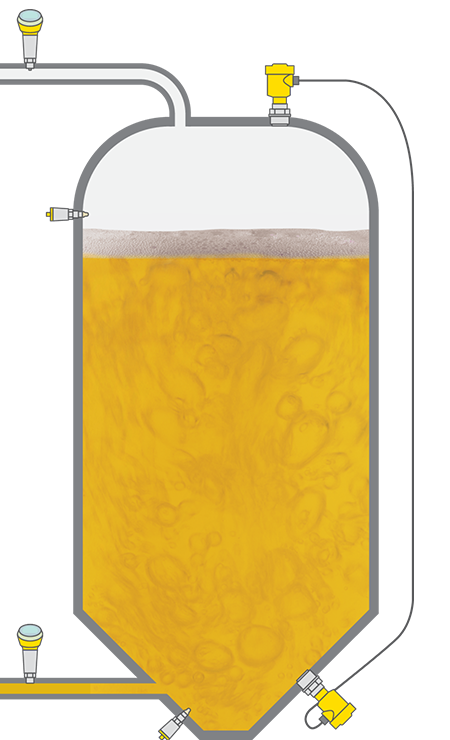Electronic differential pressure detects density changes in the beer fermentation tank: Application of the Month
There’s nothing like an ice cold beer at the end of a job well done. Whether it’s accomplishing yardwork on a hot day or a big project that takes weeks or months to accomplish, the task at hand always turns out to be more complicated or time-consuming than enjoying the end result.
Beer is no exception. There’s a lot that goes into that little can, bottle, or perfect draft pour. Perfecting the process and getting the same end result every time takes reliable and accurate instrumentation along the way.
Wort, yeast, and density
Two VEGABAR pressure transmitters connected by a cable are installed on the vessel – one near the bottom and another near the top.
Near the end of the beer-making process, wort (unfermented beer) is piped into fermentation tanks. As the sugary wort is filling the vessel, yeast is slowly added. The yeast’s job is to convert the sugars in the wort into alcohol and produce the flavors and carbon dioxide we expect from beer. This is an important step for brewers, so it requires an important measurement.
When the wort arrives at one of these fermentation tanks, it arrives at a certain, known density. As the wort reacts with the yeast, the density decreases. VEGA can use electronic differential pressure to detect the changing density. Two VEGABAR pressure transmitters connected by a cable are installed on the vessel – one near the bottom and another near the top. The sensors monitor pressure in both places, and using the pressure formula, they can calculate the density in real-time and provide it as an output.
This virtual window into the fermenter allows brewers to ensure each brew is consistent. Whether a consumer orders a draft from a tap or brings home a case from the grocery, every beer will be identical in every way a beer should.
Related applications
Fermentation tank
Level, pressure and point level measurement in the fermentation tank
After the wort has been cooled down to the appropriate temperature in the wort cooler, it is pumped into the fermentation tanks. The fermentation process is then started by adding in yeast. The yeast converts the malt sugar dissolved in the wort into carbonic acid and alcohol. To ensure optimal fermentation in the tank, the following key parameters are measured: hydrostatic pressure for determining the level, overpressure for CO2 content monitoring and limit level for overfill or dry run protection.

Reliable
Certified materials according to FDA and EC 1935/2004 regulations
Cost effective
Accurate monitoring optimizes the brewing process
User friendly
One measuring instrument, three measured values: Level, overpressure, temperature
Pressure is paramount
Learn more about VEGA’s pressure measurement instrumentation:
Export this article
Download as PDFShare this article
Comments ({{comments.length}})
{{getCommentAuthor(comment, "Anonymous")}} {{comment.timestamp | date : "dd.MM.yyyy HH:mm" }}
{{comment.comment}}






